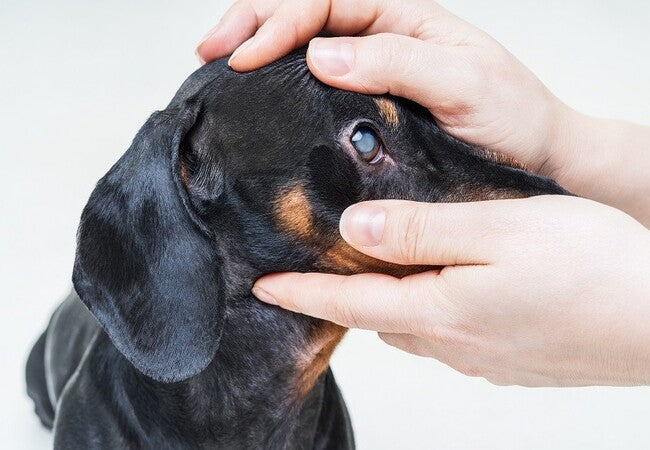Dog Cataracts 2025: Expert Veterinary Guide 🩺🐾

In this article
Dog Cataracts 2025: Expert Veterinary Guide 🩺🐾
By Dr. Duncan Houston BVSc
Hello! I’m Dr Duncan Houston BVSc, veterinarian and founder of Ask A Vet. Cataracts are an eye condition where the lens becomes cloudy, blocking light and impairing vision. In this comprehensive 2025 guide, we'll explain cataract causes, diagnostic eval, phacoemulsification surgery, recovery steps, costs, risks, and long-term eye care—plus how Ask A Vet can support you every step of the way. Let’s get started! 🐶👁️
1. 👁️ What Is a Cataract?
A cataract is an opacity of the lens that prevents light from properly reaching the retina, causing blurred vision or blindness. It often appears as a cloudy, milky-blue spot in the pupil.
2. 🎯 Causes & Risk Factors
- Genetic/hereditary: Common in breeds like Cocker Spaniels, Poodles, Boston Terriers, Labradors; juvenile cases possible.
- Aging (senile) cataracts: Develop in older dogs; nuclear sclerosis is milder and not a true cataract.
- Secondary to disease: Diabetes mellitus can rapidly trigger cataracts; inflammation (uveitis) and other eye diseases also contribute.
- Trauma or radiation: Less common, but lens damage from injury can induce cataracts.
3. 🩺 Symptoms & Signs
- Cloudy, white-blue pupil
- Reluctance in dim light, bumping into objects, seeking brighter areas
- Squinting, tearing, pawing the eye
- Advanced cataracts show no retina visible during the exam
4. 🔬 Diagnosis & Pre‑Op Evaluation
No medications can reverse cataracts—surgery is the only effective treatment. To confirm candidacy:
- Comprehensive eye exam: includes tonometry, slit‑lamp review, pupil response tests
- Electroretinogram (ERG): checks retinal function—essential before cataract removal
- Ocular ultrasound: rules out retinal detachment or other internal eye issues
- Bloodwork & systemic eval: particularly in diabetic dogs
- Inflammation control: pre-op anti-inflammatory drops are critical to reduce uveitis
5. 🧠 Phacoemulsification Surgery Explained
The standard procedure is phacoemulsification, similar to human cataract removal :
- A tiny incision was made in the lens capsule
- Ultrasonic probe breaks up and removes lens material
- Artificial intraocular lens (IOL) typically implanted
- Lens capsule and eye-opening are sutured closed
Success rates are high, 85–95% in uncomplicated cases.
6. 💊 Post‑Op Care & Recovery
- Hospital stay: Typically overnight observation
- E-collar: Rigid cone for 2–3 weeks to prevent eye trauma
- Medications: Eye drops 4–6× daily—antibiotics, steroids, NSAIDs; taper over weeks to months; some dogs may need lifelong drops
- Activity restriction: Short leash walks—avoid collars to lessen pressure around the neck
- Follow‑up visits: Days 1, 7, 14, 30; then every 6 months for life to monitor for glaucoma or inflammation
- Vision recovery: Often improved within days; full recovery by 1–2 weeks
7. ⚠️ Risks & Complications
- Uveitis (intraocular inflammation): most common, managed with meds
- Glaucoma: Infused pressure, may require lifelong drops; risk lower if surgery done early
- Retinal detachment: Rare but serious—pre-op ultrasound helps mitigate risk
- Corneal ulcers or incisional issues
- IOL complications: Fibrosis around the implant may affect vision; lens dislocation is infrequent
- Anesthetic risk: In older or diseased dogs; thorough pre-op testing minimizes complications.
8. 💵 Cost Breakdown
- Exam with ophthalmologist: $200–300
- Pre-op screening: ERG + ultrasound + bloodwork: $1,000–1,200
- Surgery per eye: $2,700–4,200; bilateral $3,500–4,200/both eyes total
- Medications & follow-ups: Additional cost depending on duration
- Insurance: Policies like Healthy Paws and Embrace may cover up to 90% if pre-existing is excluded
9. 🔄 Alternatives if Surgery Isn’t Possible
- Monitoring: Small or slow cataracts may not need surgery immediately; treat inflammation early
- Topical meds: Reduce inflammation and manage glaucoma risk, but do not cure cataracts
- Eye removal (enucleation): Option for painful, blind eyes.
10. 🧩 Ask A Vet Support
- Ask A Vet: Telehealth helps for pre-op evaluation, medication reminders, incision/red‑eye monitoring
11. 📝 Final Thoughts
Cataract surgery in 2025 offers clear chances at restoring vision, with success rates between 85–95% in well-selected cases. Thorough pre-op evaluation, meticulous surgery, and diligent aftercare are essential. With the support of Ask A Vet recovery tools and health tracking, you can confidently support your dog’s vision journey. If you notice cloudiness in your dog’s eyes, consult your veterinarian early—it makes all the difference. 🐾💙






